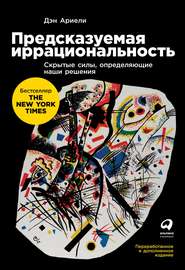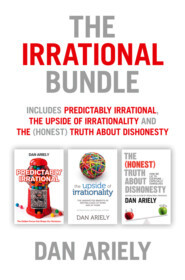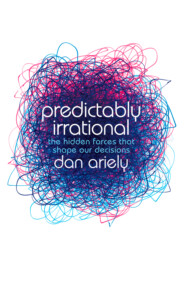По всем вопросам обращайтесь на: info@litportal.ru
(©) 2003-2024.
✖
The Upside of Irrationality: The Unexpected Benefits of Defying Logic at Work and at Home
Автор
Год написания книги
2018
Настройки чтения
Размер шрифта
Высота строк
Поля
TO TRY TO get a feeling for how a high salary might change your behavior and influence your performance, imagine the following thought experiment: What if I paid you a lot of money, say $100,000, to come up with a very creative idea for a research project in the next seventy-two hours? What would you do differently? You would probably substitute some of your regular activities with others. You would not bother with your e-mail; you wouldn’t check Facebook; you wouldn’t leaf through a magazine. You would probably drink a lot of coffee and sleep much less. Maybe you would stay at the office all night (as I do from time to time). This means that you would work more hours, but would doing any of this help you be more creative?
Hours spent working aside, let’s consider how your thought process would change during those critical seventy-two hours. What would you do to make yourself more creative and productive? Would you close your eyes harder? Would you visualize a mountaintop? Bite your lips to a larger degree? Breathe deeply? Meditate? Would you be able to chase away random thoughts more easily? Would you type faster? Think more deeply? Would you do any of those things and would they really lead you to a higher level of performance?
This is just a thought experiment, but I hope it illustrates the idea that though a large amount of money would most likely get you to work many hours (which is why high payment is very useful as an incentive when simple mechanical tasks are involved), it is unlikely to improve your creativity. It might, in fact, backfire, because financial incentives don’t operate in a simple way on the quality of output from our brains. Nor is it at all clear how much of our mental activity is really under our direct control, especially when we are under the gun and really want to do our best.
NOW LET’S IMAGINE that you need a critical, lifesaving surgery. Do you think that offering your medical team a skyhigh bonus would really result in improved performance? Would you want your surgeon and anesthesiologist to think, during the operation, about how they might use the bonus to buy a sailboat? That would clearly motivate them to get the bonus, but would it get them to perform better? Wouldn’t you rather they devoted all of their mental energy to the task at hand? How much more effective might your doctors be in what the psychologist Mihály Csíkszentmihályi called a “state of flow”—when they are fully engaged and focused on the task at hand and oblivious to anything else? I’m not sure about you, but for important tasks that require thinking, concentration, and cognitive skill, I would take a doctor who’s in a flow state any day.
A Few Words about Small and Large Decisions
For the most part, researchers like me carry out laboratory-based experiments. Most of these involve simple decisions, short periods of time, and relatively low stakes. Because traditional economists usually do not like the answers that our lab experiments produce, they often complain that our results do not apply to the real world. “Everything would change,” they say, “if the decisions were important, the stakes were higher, and people tried harder.” But to me, that’s like saying that people always get the best care in the emergency room because the decisions made there are often literally life and death. (I doubt many people would argue that this is the case.) Absent empirical evidence one way or the other, such criticism of laboratory experiments is perfectly reasonable. It is useful to have some healthy skepticism about any results, including those generated in relatively simple lab experiments. Nevertheless, it is not clear to me why the psychological mechanisms that underlie our simple decisions and behaviors would not be the same ones that underlie more complex and important ones.
CARING AS A DOUBLE-EDGED SWORD
First Knight, a movie that came out in 1995 starring Sean Connery and Richard Gere, demonstrates one extreme way of dealing with the way motivation affects performance. Richard Gere’s character, Sir Lancelot, is a vagabond expert swordsman who duels to pay the bills. Toward the beginning of the film, he sets up a kind of mini sparring clinic where the villagers pay to test their skills against him while he dispenses witty advice for their improvement. At one point, Lancelot suggests that someone out there must be better than he, and wouldn’t that person love to win the gold pieces he happens to have clinking around in a bag?
Finally, an enormous blond man named Mark challenges him. They fight furiously for a brief time. Then, of course, Lancelot disarms Mark. The latter, confused, asks Lancelot how he managed to disarm him and whether it was a trick. Lancelot smilingly says that that’s just how he fights, no trick to it. (Well, there is one mental trick, as we discover later.) When Mark asks Lancelot to teach him, Lancelot pauses for a moment before giving his lesson. He offers Mark three tips: first, to observe the man he’s fighting and learn how he moves and thinks; second, to await the make-or-break moment in the match and go for it then. Up to that point, Mark smiles and nods happily, sure he can learn to do those things. Lancelot’s final tip, however, is a little more difficult to follow. He tells his eager student that he can’t care about living or dying. Mark stares into his face, astonished; Lancelot smiles sadly and walks off into the sunset like a medieval cowboy.
Judging from this advice, it seems that Lancelot fights better than anyone else because he has found a way to bring the stress of the situation to zero. If he doesn’t care whether he lives or dies, nothing rides on his performance. He doesn’t worry about living past the end of the fight, so nothing clouds his mind and affects his abilities—he is pure concentration and skill.
Seen from this perspective, the findings presented in this chapter suggest that our tendency to behave irrationally and in ways that are undesirable might increase when the decisions are more important. In our India experiment, the participants behaved very much as standard economics would predict when the incentives were relatively low. But they did not behave as standard economics would predict when it really mattered and the incentives were highest.
COULD ALL THIS mean that sometimes we might actually behave less rationally when we try harder? If that’s so, what is the correct way to pay people without overstressing them? One simple solution is to keep bonuses low—something those bankers I met with might not appreciate. Another approach might be to pay employees on a straight salary basis. Though it would eliminate the consequences of overmotivation, it would also eradicate some of the benefits of performance-based payment. A better approach might be to keep the motivating element of performance-based payment but eliminate some of the nonproductive stress it creates. To achieve this, we could, for example, offer employees smaller and more frequent bonuses. Another approach might be to offer employees a performance-based payment that is averaged over time—say, the previous five years, rather than only the last year. This way, employees in their fifth year would know 80 percent of their bonus in advance (based on the previous four years), and the immediate effect of the present year’s performance would matter less.
Whatever approach we take to optimize performance, it should be clear that we need a better understanding of the links between compensation, motivation, stress, and performance. And we need to take our peculiarities and irrationalities into account.
P.S. I WOULD like to dedicate this chapter to my banker friends, who repeatedly “enjoy” hearing my opinion about their salaries and are nevertheless still willing to talk to me.
CHAPTER 2 The Meaning of Labor (#ulink_479b101a-9d06-551e-884f-acf34d82727c)
What Legos Can Teach Us about the Joy of Work
On a recent flight from California, I was seated next to a professional-looking man in his thirties. He smiled as I settled in, and we exchanged the usual complaints about shrinking seat sizes and other discomforts. We both checked our e-mail before shutting down our iPhones. Once we were airborne, we got to chatting. The conversation went like this:
HE: So how do you like your iPhone?
ME: I love it in many ways, but now I check my e-mail all the time, even when I am at traffic lights and in elevators.
HE: Yeah, I know what you mean. I spend much more time on e-mail since I got it.
ME: I’m not sure if all these technologies make me more productive, or less.
HE: What kind of work do you do?
Whenever I’m on a plane and start chatting with the people sitting next to me, they often ask or tell me what they do for a living long before we exchange names or other details about our lives. Maybe it’s a phenomenon more common in America than in other places, but I’ve observed that fellow travelers everywhere—at least the ones who make conversation—often discuss what they do for a living before talking about their hobbies, family, or political ideology.
The man sitting next to me told me all about his work as a sales manager for SAP, a large business management software firm that many companies use to run their back-office systems. (I knew something about the technology because my poor, suffering assistant at MIT was forced to use it when the university switched to SAP.) I wasn’t terribly interested in talking about the challenges and benefits of accounting software, but I was taken by my seatmate’s enthusiasm. He seemed to really like his job. I sensed that his work was the core of his identity—more important to him, perhaps, than many other things in his life.
ON AN INTUITIVE level, most of us understand the deep interconnection between identity and labor. Children think of their potential future occupations in terms of what they will be (firemen, teachers, doctors, behavioral economists, or what have you), not about the amount of money they will earn. Among adult Americans, “What do you do?” has become as common a component of an introduction as the anachronistic “How do you do?” once was—suggesting that our jobs are an integral part of our identity, not merely a way to make money in order to keep a roof over our heads and food in our mouths. It seems that many people find pride and meaning in their jobs.
In contrast to this labor-identity connection, the basic economic model of labor generally treats working men and women as rats in a maze: work is assumed to be annoying, and all the rat (person) wants to do is to get to the food with as little effort as possible and to rest on a full belly for the most time possible. But if work also gives us meaning, what does this tell us about why people want to work? And what about the connections among motivation, personal meaning, and productivity?
Sucking the Meaning out of Work
In 2005, I was sitting in my office at MIT, working on yet another review,
(#litres_trial_promo) when I heard a knock at the door. I looked up and saw a familiar, slightly chubby face belonging to a young man with brown hair and a funny goatee. I was sure I knew him, but I couldn’t place him. I did the proper thing and invited him in. A moment later I realized that he was David, a thoughtful and insightful student who had taken my class a few years earlier. I was delighted to see him.
Once we were settled in with coffee, I asked David what had brought him back to MIT. “I’m here to do some recruiting,” he said. “We’re looking for new blood.” David went on to tell me what he’d been up to since graduating a few years earlier. He’d landed an exciting job in a New York investment bank. He was making a high salary and enjoying fantastic benefits—including having his laundry done—and loved living in the teeming city. He was dating a woman who, from his description, seemed to be a blend of Wonder Woman and Martha Stewart, though admittedly they had been together for only two weeks.
“I also wanted to tell you something,” he said. “A few weeks ago, I had an experience that made me think back to our behavioral economics class.”
He told me that earlier that year he’d spent ten weeks on a presentation for a forthcoming merger. He had worked very hard on analyzing data, making beautiful plots and projections, and he had often stayed in the office past midnight polishing his PowerPoint presentation (what did bankers and consultants do before PowerPoint?). He was delighted with the outcome and happily e-mailed the presentation to his boss, who was going to make the presentation at the all-important merger meeting. (David was too low in the hierarchy to actually attend the meeting.)
His boss e-mailed him back a few hours later: “Sorry, David, but just yesterday we learned that the deal is off. I did look at your presentation, and it is an impressive and fine piece of work. Well done.” David realized that his presentation would never see the light of day but that this was nothing personal. He understood that his work shone, because his boss was not the kind of person who gave undeserved compliments. Yet, despite the commendation, he was distraught with the outcome. The fact that all his effort had served no ultimate purpose created a deep rift between him and his job. All of a sudden he didn’t care as much about the project in which he had invested so many hours. He also found that he didn’t care as much about other projects he was working on either. In fact, this “work to no end” experience seemed to have colored David’s overall approach to his job and his attitude toward the bank. He’d quickly gone from feeling useful and happy in his work to feeling dissatisfied and that his efforts were futile.
“You know what’s strange?” David added. “I worked hard, produced a high-quality presentation, and my boss was clearly happy with me and my work. I am sure that I will get very positive reviews for my efforts on this project and probably a raise at the end of the year. So, from a functional point of view, I should be happy. At the same time, I can’t shake the feeling that my work has no meaning. What if the project I’m working on now gets canceled the day before it’s due and my work is deleted again without ever being used?”
Then he offered me the following thought experiment. “Imagine,” he said in a low, sad voice, “that you work for some company and your task is to create PowerPoint slides. Every time you finish, someone takes the slides you’ve just made and deletes them. As you do this, you get paid well and enjoy great fringe benefits. There is even someone who does your laundry. How happy would you be to work in such a place?”
I felt sorry for David, and in an attempt to comfort him, I told him a story about my friend Devra, who worked as an editor at one of the major university presses. She had recently finished editing a history book—work she had enjoyed doing and for which she had been paid. Three weeks after she submitted the final manuscript to the publishing house, the head editor decided not to print it. As was the case with David, everything was fine from a functional point of view, but the fact that no readers would ever hold the book in their hands made her regret the time and care she had put into editing it. I was hoping to show David that he was not alone. After a minute of silence he said, “You know what? I think there might be a bigger issue around this. Something about useless or unrequited work. You should study it.”
It was a great idea, and in a moment, I’ll tell you what I did with it. But before we do that, let’s take a detour into the worlds of a parrot, a rat, and contrafreeloading.
Will Work for Food
When I was sixteen, I joined the Israeli Civil Guard. I learned to shoot a World War II–era Russian carbine rifle, set up roadblocks, and perform other useful tasks in case the adult men were at war and we youth were left to protect the home front. As it turned out, the main benefit of learning how to shoot was that from time to time it excused me from school. In those years in Israel, every time a high school class went on a trip, a student who knew how to use a rifle was asked to join it as a guard. Since this duty also meant substituting a few days of classes with hiking and enjoying the countryside, I was always willing to volunteer, even if I had to give up an exam for the call of duty.
(#litres_trial_promo)
On one of these trips I met a girl, and by the end of the trip I had a crush on her. Unfortunately, she was one class behind me in school and our schedules did not coincide, making it difficult for me to see her and learn whether she felt the same about me. So I did what any moderately resourceful teenager would do: I discovered an extracurricular interest of hers and made it mine as well.
About a mile from our town lived a guy we called “Birdman” who had endured a miserable and lonely childhood in Eastern Europe during the Holocaust. Hiding from the Nazis in the forest, he found much comfort in the animals and birds around him. After he eventually made it to Israel, he decided to try to make the childhood of the kids around him much better than his, so he collected birds from all over the globe and invited children to come and experience the wonders of the avian world. The girl I liked used to volunteer in the Birdman’s aviary, and so I joined her in cleaning cages, feeding the birds, telling visitors stories about them, and—most amazingly—watching the birds hatch, grow, and interact with one another and the visitors. After a few months, it became clear that the girl and I had no future but the birds and I did, so I continued to volunteer for a while.
Some years later, after my main hospitalization period, I decided to get a parrot. I selected a relatively large, highly intelligent Mealy Amazon parrot and named her Jean Paul. (For some reason, I decided that female parrots should have French male names.) She was a handsome bird; her feathers were mostly green with some light blue, yellow, and red at the tips of her wings, and we had lots of fun together. Jean Paul loved talking and flirting with nearly everyone who happened by her cage. She would come near me to be petted any time I passed her cage, bowing her head very low and exposing the back of her neck, and I would try to produce baby talk as I ruffled the feathers on her neck. Whenever I took a shower, she would perch in the bathroom and twitch happily when I splashed water drops at her.
Jean Paul was intensely social. Left alone in her cage for too long, she would pluck at her own feathers, something she did when she was bored. As I discovered, parrots have a particularly acute need to engage in mental activity, so I invested in several toys specifically designed to preclude parrot boredom. One such puzzle, called SeekaTreat, was a stack of multicolored wooden tiers of decreasing size that form a kind of pyramid. Made of wood, the tiers were connected through the center with a cord. Within each tier, there were half-inch-deep “treat wells” designed to hold tasty parrot treats. To get at the food, Jean Paul had to lift each tier and uncover the treat, which was not very easy to do. Over the years, the SeekaTreat and other toys like it kept Jean Paul happy, curious, and interested in her environment.
THOUGH I DIDN’T know it at the time, there was an important concept behind the SeekaTreat. “Contrafreeloading,” a term coined by the animal psychologist Glen Jensen, refers to the finding that many animals prefer to earn food rather than simply eating identical but freely accessible food.
To better understand the joy of working for food, let’s go back to the 1960s when Jensen first took adult male albino rats and tested their appetite for labor. Imagine that you are a rat participating in Jensen’s study. You and your little rodent friends start out living an average life in an average cluster of cages, and every day, for ten days, a nice man in a white lab coat gives you 10 grams of finely ground Purina lab crackers precisely at noon (you don’t know it’s noon, but you eventually pick up on the general time). After a few days of this pattern, you learn to expect food at noon every day, and your rat tummy begins rumbling right before the nice man shows up—exactly the state Jensen wants you in.
Once your body is conditioned to eating crackers at noon, things suddenly change. Instead of feeding you at the time of your maximal hunger, you have to wait another hour, and at one o’clock, the man picks you up and puts you in a well-lit “Skinner box.” You are ravenous. Named after its original designer, the influential psychologist B. F. Skinner, this box is a regular cage (similar to the one you are used to), but it has two features that are new to you. The first is an automated food dispenser that releases food pellets every thirty seconds. Yum! The second is a bar that for some reason is covered with a tin shield.
At first, the bar isn’t very interesting, but the food dispenser is, and that is where you spend your time. The food dispenser releases food pellets every so often for twenty-five minutes, until you have eaten fifty food pellets. At that point you are taken back to your cage and given the rest of your food for the day.
The next day, your lunch hour passes by again without food, and at 1:00 P.M. you are placed back into the Skinner box. You’re ravenous but unhappy because this time the food dispenser doesn’t release any pellets. What to do? You wander around the cage, and, passing the bar, you realize that the tin shield is missing. You accidentally press the bar, and immediately a pellet of food is released. Wonderful! You press the bar again. Oh joy!—another pellet comes out. You press again and again, eating happily, but then the light goes off, and at the same time, the bar stops releasing food pellets. You soon learn that when the light is off, no matter how much you press the bar, you don’t get any food.
Just then the man in the lab coat opens the top of the cage and places a tin cup in a corner of the cage. (You don’t know it, but the cup is full of pellets.) You don’t pay attention to the cup; you just want the bar to start producing food again. You press and press, but nothing happens. As long as the light is off, pressing the bar does you no good. You wander around the cage, cursing under your rat breath, and go over to the tin cup. “Oh my!” you say to yourself. “It’s full of pellets! Free food!” You begin chomping away, and then suddenly the light comes on again. Now you realize that you have two possible food sources. You can keep on eating the free food from the tin cup, or you can go back to the bar and press it for food pellets. If you were this rat, what would you do?














